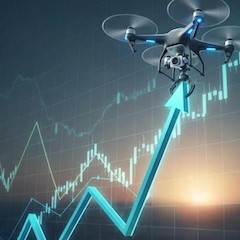
Igniting the Drone Revolution
In 2017, I told people they could make $50,000 a week with drones. People thought I was crazy.
Back then, drones were toys. Maybe you'd spot one at a tech conference or see a rich kid flying one at the park.
Most businesses had no idea what to do with them.
Eight years later, those "toys" are everywhere.
They take photos of real estate listings. They record videos at fancy parties. They spray crops and inspect power lines.
But here's the crazy part. We're still in the stone age of drone technology.
Why? Because every single drone still needs a human to fly it.
That's about to change in a big way.
Spotlight on Drones
Earlier this month, Ukraine pulled off a modern version of a Trojan Horse.
For 18 months, Ukrainian intelligence secretly smuggled hundreds of small drones into Russia using regular trucks.
When the moment came, these hidden drones launched at once.
They destroyed at least 22 Russian bomber planes worth billions of dollars.
Each drone cost just a few hundred dollars.
Two weeks later, Israel did something similar.
They had secretly positioned drone teams inside Iran for months.
When Israel struck Iranian nuclear sites, these hidden drones attacked first.
They knocked out Iran's air defenses and let Israeli jets take complete control of Iranian airspace in just a few hours.
But the battlefield isn’t the only place where drones are getting attention.
Walmart announced earlier this month that it will bring drone delivery to five new cities.
Since 2021, they've dropped over 150,000 packages from the sky.
Now they want to do a lot more.
Customers in five cities will soon be able to get eggs, ice cream, and medicine dropped at their door in 30 minutes or less.
How AI Can Solve the “Pilot” Problem
All these operations still need human pilots.
Ukraine's Spider's Web needed teams of people flying drones in shifts.
Israel's Iran mission required multiple human controllers working together.
Every Walmart delivery needs a person watching the flight.
This creates a big limit.
You can only fly as many drones as you have trained people.
Managing airspace for dozens of flights at once becomes impossible for humans.
For drones to realize their full potential, we’re going to need to be able to coordinate the movements of tens of thousands of drones simultaneously.
That's where AI changes the game.
In April, a computer beat the world's best drone pilots at their own sport.
At a racing championship in Abu Dhabi, an AI drone from a Dutch university destroyed the competition.
The AI didn't just win. It beat three former world champions.
The computer-controlled drone completed the course with 22 gates in just 17 seconds.
It hit speeds of nearly 60 miles per hour on a winding track designed to challenge the best pilots in the world.
The winning team built computer brains that sent commands straight to the drone's motors.
Old autopilot systems are too slow for high-speed flying.
The AI had to see obstacles and make decisions faster than any human could.
It learned by practicing millions of times on a computer before flying for real.
The drone used just one camera to spot gates, avoid crashes, and stay in control at top speed.
Most importantly, it worked reliably with bad lighting, wind, and interference.
This proves AI is reaching the point where it can handle the hardest flying jobs.
If computers can beat humans at drone racing, they can easily manage delivery flights or military missions.
Instead of needing one person per drone, a single AI system could control hundreds or thousands of drones at once.
Picture Walmart launching 1,000 delivery drones every hour in a big city.
Each drone would avoid other aircraft, find its destination, and come back for the next job.
No human pilots needed.
Or think about military uses where AI coordinates massive drone swarms.
Each drone would share information with others instantly, adapting to new situations without human help.
The technology is getting better fast.
AI and drone technology coming together is creating opportunities that seemed impossible just a few years ago.
For investors wanting to profit from this trend, several public companies offer ways to invest in the drone revolution.
The AI Drone Opportunity
Unusual Machines Inc (UMAC), Red Cat Holdings Inc (RCAT), and AeroVironment Inc (AVAV) are just 3 of the many companies that develop drones with AI capabilities for military and civilian purposes.
These companies sit where two powerful technology trends meet.
And while I’m not officially recommending UMAC or RCAT today, AVAV is an opportunity that we’ve previously recommended and are tracking in the Altucher’s Investment Network portfolio.
The drone market keeps growing fast, and AI is removing the last big barrier to widespread use.
We're seeing the start of a change that will reshape industries from shipping to farming to national defense.
Just like the internet created whole new types of businesses, self-flying drone technology will unlock possibilities we haven't thought of yet.
The companies that master AI-powered drone systems today will control the skies tomorrow.
For early investors who spot this shift, the wealth creation potential could be life-changing.
Want More Altucher's Investment Network Pro?
Do you like this content? Would you like to know more? Because we have this and much more to share with you. Get started today!









